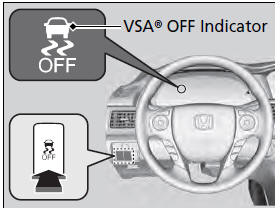 Honda Accord: VSA® (Vehicle Stability Assist), aka ESC(Electronic Stability Control), System
Honda Accord: VSA® (Vehicle Stability Assist), aka ESC(Electronic Stability Control), System
VSA® helps to stabilize the vehicle during cornering if the vehicle turns more or less than what was intended. It also assists in maintaining traction on slippery surfaces.
It does so by regulating engine output and selectively applying the brakes.
The VSA® may not function properly if tire type and size are mixed. Make sure to use the same size and type of tire, and the air pressures as specified.
When the VSA® indicator comes on and stays on while driving, there may be a problem with the system. While this may not interfere with normal driving, have your vehicle checked by a dealer immediately.
VSA® cannot enhance stability in all driving situations and does not control the entire braking system. You still need to drive and corner at speeds appropriate for the conditions and always leave a sufficient margin of safety.
The main function of the VSA® system is generally known as Electronic Stability Control (ESC). The system also includes a traction control function.
Without VSA®, your vehicle will have normal braking and cornering ability, but it will not have VSA® traction and stability enhancement.
In certain unusual conditions when your vehicle gets stuck in shallow mud or fresh snow, it may be easier to free it with the VSA® temporarily switched off.
When the VSA® system is off, the traction control system is also off. You should only attempt to free your vehicle with the VSA® off if you are not able to free it when the VSA® is on.
Immediately after freeing your vehicle, be sure to switch VSA® on again. We do not recommend driving your vehicle with the VSA® and traction control systems switched off.
If the low tire pressure/TPMS indicator comes on or
blinks, the VSA® system comes on automatically. In
this case, you cannot turn the system off by pressing
 the button.
the button.
You may hear a motor sound coming from the engine compartment while system checks are being performed immediately after starting the engine or while driving. This is normal.
• VSA® Operation

When VSA® activates, you may notice that the engine does not respond to the accelerator.
You may also notice some noise from the hydraulic system. You will also see the indicator blink.
• VSA® On and Off

This button is on the driver side control panel.
To turn the VSA® system on and off, press and hold it until you hear a beep.
VSA® will stop and the indicator will come on.
To turn it on again, press the (VSA® OFF) button until you hear a beep.
VSA® is turned on every time you start the engine, even if you turned it off the last time you drove the vehicle.
 Lane Departure Warning (LDW)*
Lane Departure Warning (LDW)*
Alerts you when the system detects a possibility of your vehicle
unintentionally
crossing over left or right side lane markings.
• How the System Works
If your vehicle is getting too close t ...
 LaneWatch TM*
LaneWatch TM*
Is an assistance system that allows you to check the passenger side rear
areas
displayed on the audio/information screen when the turn signal is activated to
the
passenger’s side. A camera i ...
See also:
Security Hood Switch Test
1. Open the hood.
2. Disconnect the 2P connector from the security hood
switch.
3. Check for continuity between the terminals.
• There should be continuity between terminals No. 1
and ...
Cooling System
...
A/T Gear Position Indicator Panel Light
Harness Replacement
Type A Shift Lever
NOTE: The A/T gear position indicator panel light
harness and the park pin switch are not available
separately. Replace the A/T gear position indicator panel
light harness and t ...
